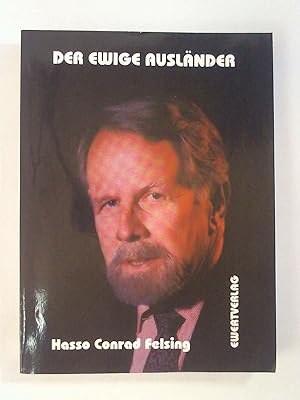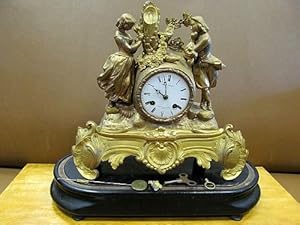felsing conrad (5 resultados)
Tipo de artículo
- Todo tipo de artículos
- Libros (4)
- Revistas y publicaciones
- Cómics
- Partituras
- Arte, grabados y pósters
- Fotografías
- Mapas
-
Manuscritos y
coleccionismo de papel (1)
Condición
- Todo
- Nuevos
- Antiguos o usados
Encuadernación
- Todo
- Tapa dura
- Tapa blanda (1)
Más atributos
- Primera edición
- Firmado
- Sobrecubierta
- Con imágenes del vendedor (3)
- Sin impresión bajo demanda
Ubicación del vendedor
Valoración de los vendedores
-
Der ewige Ausländer
Publicado por Mühlentannen, Ewert,, 2000
ISBN 10: 3894782242ISBN 13: 9783894782245
Librería: Antiquariat am Roßacker, Rosenheim, Alemania
Libro
8°, Brosch. 259 S. Mit Photographien, leicht schiefgelesen, sonst gut Sprache: Deutsch Gewicht in Gramm: 550.
-
Der ewige Ausländer.
Publicado por Ewertverlag
ISBN 10: 3894782242ISBN 13: 9783894782245
Librería: Buchmerlin, Essen, Alemania
Libro
Taschenbuch. Zustand: Sauberes Buch in gutem Zustand - Werktaeglicher Versand im Luftpolsterumschlag - Rechnung mit ausgewiesener MwSt kommt automatisch per Mail ! Stichworte: - Der ewige Ausländer Auto-Biografie - Ewert-Verlag Auto-Biographie - Hasso Conrad Felsing Deutsch 111g.
-
D. Elisabethae Borboniae Principi. 1656.
Publicado por Darmstadt, Germany: Johann Velten, [ca. 1820]., 1820
Librería: Wittenborn Art Books, San Francisco, CA, Estados Unidos de America
Manuscrito
Condición: Good. Engraving mounted on backing paper. 4to. Very Good with minor creasing. Text in French.
-
Bronzierte Kaminuhr. Ein junges Liebespaar umrahmt die Uhr und das Mädchen ritzt die Anfangsinitialen in einen Baumstumpf einer Eiche.
Librería: Antiquariat Friederichsen, Hamburg, Alemania
Miembro de asociación: BOEV
Die Kaminuhr ist 31 cm maximal breit, 30 cm maximale Höhe bei einer Tiefe von 10 cm. Das emaillierte Uhrenzifferblatt ist gemarkt mit *Conrad Felsing, Brüderstrasse No. 20, Berlin*, das Uhrwerk innen ebenfalls gemarkt mit *Conrad Felsing, Berlin* sowie der Typenbezeichnung *5453* der untere Sockel der Uhr verso gemarkt mit *10 Ph. Mouray*. Die Uhr wohl aus bronziertem Eisen (?) mit einer bronzenen Schmuckblende und bronzenen Applikationen am Sockel und Aufbau der Uhr. Das Pendel und der Schlüssel liegen lose bei, ebenso ein loses kleines Teil ( ein kleiner abgebrochener Ast oben an der Uhr ). Die Uhr ist nicht richtig funktionstüchtig, das Ziffernblat ist etwas fleckig, die Uhr teils berieben bzw. teils etwas oxydiert. Wohl um 1840-1850 herum gefertigt. ( Gewicht 3000 Gramm ). Die Uhr steht auf einem schwarzlackiertem Holzsockel, dieser verso handschriftlich beschriftet ( unleserlich ), der Holzsockel stärker berieben sowie mit kleiner Beschädigung. Der Glassturz hierzu fehlt. >>>Johann Conrad Felsing: wurde im Schwarzwald geboren, wo die Familie Völtzing seit dem Jahre 1733 Uhren herstellte, sein Geburtsdatum ist nicht bekannt. Um 1820 herum siedelte Johann Conrad Völtzing nach Berlin um und änderte seinen Name in Felsing. Er gründete die Firma Conrad Felsing, zuerst am Schloßfreiheit No. 1, Berlin, später Unter der Linden 20 in Berlin. 1847 wurde Conrad Mitglied der Innung und 1850 Altmeister. Die Firma wurde zum Hof-Uhrmacher benannt. Johann Felsing wurde um 1878 in Berlin als Sohn von Hofuhrmacher Albert Karl Julius Felsing geboren. Er übernahm nach dem Tod seines Vaters 1901 die Firma Conrad Felsing in Berlin. Ein Teil des Geschäftshauses wurde von Willibald Felsing an den Optiker und Instrumentenmacher Oskar Messter vermietet, der hier das erste Berliner Filmstudio einrichtete. Hierdurch erlangte Felsing Kontakte mit der Theater und Filmwelt, was später auch seiner Nichte Marlene Dietrich nutzte, die ihn Onkel Willi nannte. Das Schaufenster der Firma neben dem Hotel Adlon, ganz in der Nähe vom Brandenburger Tor, war weitbekannt und in jedem Baedeker als ein Wahrzeichen von Berlin aufgeführt. Hier pendelte eine Weltuhr.mit der zentralen Anzeige der Zeit in Berlin - hierum acht kleinere Zifferblätter mit Angabe der Zeit in London, New York, San Francisco, Tokio, Bangkok, Karatchi, Teheran und Moskau. 1924 gründete Willi König und Willibald Albert Conrad Felsing aus dem "Zentralverband der Deutschen Uhrmacher" die Firma "Markenuhr GmbH". Als Marke wurde ZentRa verwendet bzw. übernommen. 1927 wurde daraus die "ZentRa Garantiegemeinschaft e.V." gegründet. Ab 1940 war die Firma an den Fertigstellungsarbeiten der A. Lange & Söhne Beobachtungsuhr Kaliber 48 beteiligt. Die Firma Conrad Felsing blieb bis zm Ende des Zweiten Weltkriegs in ihrem Geschäft in der Straße Unter den Linden in Berlin bis zur Zerstörung tätig. <<< ( Pic erhältlich // webimage available ) ( Für freundliche Hinweise zur Entstehung der Uhr danke ich Herrn Fabianke ) ( Lagerort Fensterbank )( Bitte beachten: Hier ist leider kein Versand möglich - hier bitte nur Selbstabholung oder selbst organisierter Abtransport nach Absprache // please notice: No shipment possible ) ( Bitte beachten: Export außerhalb der EU nur auf Anfrage / export outside the EU only at request )( Weitere Bilder auf Anfrage / further pics at request ).
-
Karte von Hessen-Darmstadt.
Publicado por Frankfurt: Heinrich Ludwig Broenner, 1790, 1790
Librería: Arader Galleries - AraderNYC, New York, NY, Estados Unidos de America
HAAS, Johann Heinrich - FELSING, Johann Conrad (1766-1819). Karte von Hessen-Darmstadt. Frankfurt: Heinrich Ludwig Broenner, 1790 EXCEPTIONALLY FINE folding engraved map in 15 sheets (each sheet 20 4/8 x 25 inches), each laid down on linen in 12 sections, centred on Darmstadt and showing in great detail the landgraviate of Hesse-Darmstadt, and the route of the Rhine and its tributaries from Frankfurt in the north to Frankenthal in the south, but extending to cover Hanau, Reinheim and Manheim to the east. Preserved in contemporary tree calf solander boxes, with red and black morocco lettering-pieces on the spine. Provenance: with the supra libros on the case of Ernest Augustus (1771 1851), king of Hanover, fifth son of George III and Queen Charlotte, as Duke of Cumberland, his sale Sotheby's 16th December 2010, lot 50 The map which includes Darmstadt has the title "I. Bogen der angekündigten Situations-Charte, aufgenommen und gezeichnet durch Maaß, Artillerie-Lieutenant zu Darmstadt" along the top margin. Hesse-Darmstadt was originally only the small territory of Upper Katzenelnbogen with Darmstadt, being situated in what is now the extreme southern portion of the present-day Land (state) of Hessen. "But the landgraviate received significant accretions of territory during the 17th and 18th centuries, partly owing to its steadfast loyalty to the Habsburg Holy Roman emperors. Hesse-Darmstadt entered Napoleon s Confederation of the Rhine in 1806 and was consequently raised to the status of a grand duchy in that year. Hesse-Darmstadt joined the allies in 1813 and entered the German Confederation in 1815. The Congress of Vienna ceded some of Hesse-Darmstadt s lands to Prussia and Bavaria but in compensation gave the duchy, among other territories, a district on the west bank of the Rhine containing the important cities of Mainz and Worms. The grand duke Louis I (reigned 1768 1830) granted Hesse-Darmstadt a constitution in 1820, carried through other reforms, and made the grand duchy the first of the southern German states to join the Prussian Zollverein (Customs Union). Hesse-Darmstadt thereafter oscillated between liberalism and conservatism. The duchy sided with the Austrians in the Seven Weeks War (1866) and consequently lost its territory north of the Main River to the Prussian-sponsored North German Confederation. But when the German empire was founded in 1871, Hesse-Darmstadt became one of its constituent states" (Encyclopedia Britannica online). Created duke of Cumberland and Teviotdale, and earl of Armagh, in April 1799, Prince Ernest "slim, tall, and handsome in his youth wished to follow a military career and in June 1790 sought permission to train with the Prussian army. But George III insisted he should serve with the 9th Hanoverian hussars (which he entered as lieutenant in 1790 and of which he became lieutenant-colonel in 1793), later transferring him to the less dashing heavy dragoons, a move the prince bitterly resented. He was promoted major-general in the Hanoverian army in February 1794. He fought with courage in Flanders and the Netherlands against the French. When commanding the Hanoverian light battalion of grenadiers at Villers-en-Cauchi on 6 August 1793 he behaved remarkably well, with the greatest coolness and spirit (The Later Correspondence of George III, ed. A. Aspinall, 5 vols., 1962 70, 2.72) and apparently carried off bodily a French dragoon officer as prisoner; a similar event has been ascribed to Ernest outside Nijmegen in November 1794" (DNB). Never very popular in England, and often surrounded by the whiff of scandal, including accusations of murder and incest, from 1818 to 1828 the Cumberlands lived in voluntary exile, mostly in Berlin. As Victoria's eldest surviving uncle the duke was certain of accession in Hanover, becoming King in June of 1837.






